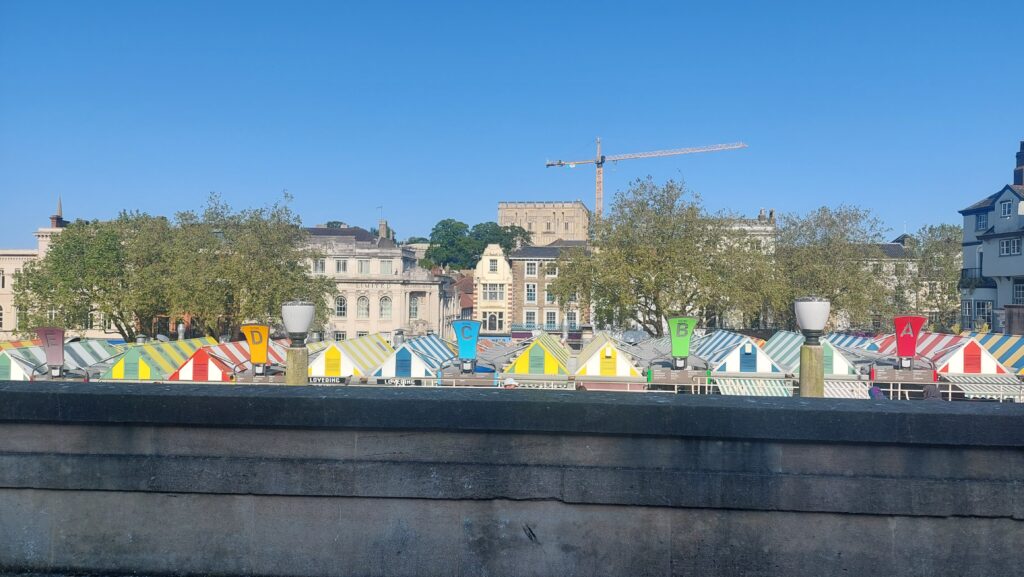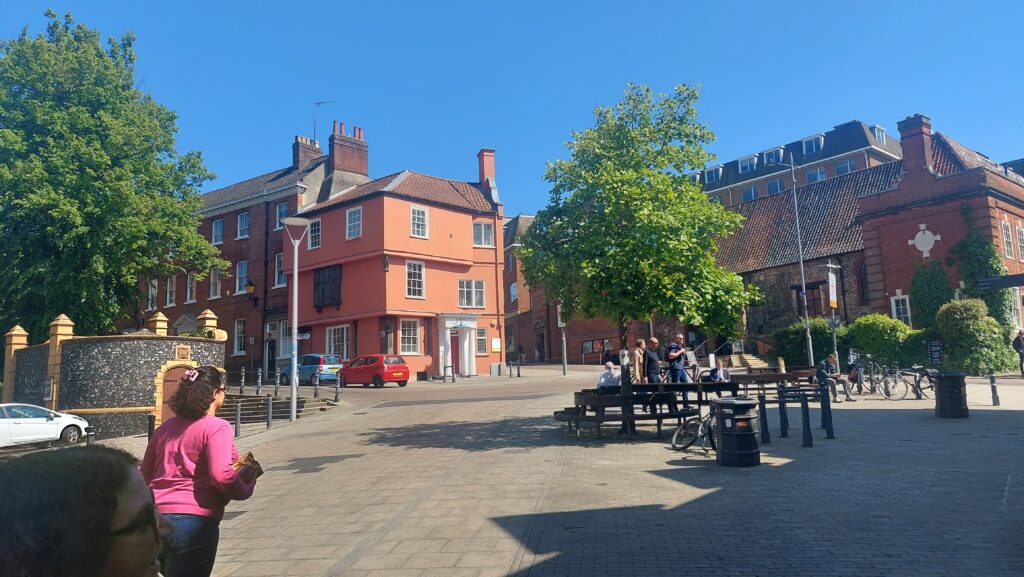
The Future History of Norwich – a Fan Fiction, Part 2
- Uncategorized
- July 3, 2023
Continuing my look at the history of the Star Trek universe as seen from the perspective of Norwich, England. Last time we saw how Norwich fared through the darker chapters of the 21st century. This week we enter the 22nd century, and it has been a long road…

It is 2100 in Norwich
The skies are filled with fireworks and the streets with people, although perhaps not as many as the celebrations 100 years before. The general vibe is one of relief. The roofs are lined with solar panels and mini-windmill generators. Hydroponic tower gardens fill the skyline. Spider-webs of yellow light are now visible on the moon, but nobody looks at them much anymore.
The space program that brought the aliens to us seems at first to be a glimmer of hope, but all it did was take the best and brightest away, to worlds that have more of a future than this one. And even then- none of those best or brightest come from Norwich. Those who’ve stayed behind have become defiant homesteaders.
Everyone in Norwich is a farmer, but some of those farmers have started going through the materials stored at the old university, itself a giant agricultural commune by now. Old research is dusted off, and built on. New techniques are found that deliver better yields.
Farming for food is intermingled with solar and wind farms. A larger, more integrated electric grid is emerging, but one that is far less centralised than the pre-war electrical infrastructure. Most homes now generate their own power.

It is 2123 in Norwich
The spider-webs are across the moon spread further and brighter, but now more lights, mostly of red and blue, fill the sky. Orbital shipyards and starships, alien and human, are coming and going across the night. The hydroponic towers are changing in design, with architecture, designed by aliens and more distant humans augmenting them as they turn from food factories to giant vertical parks. And the people walking the streets look different their clothes are more extravagant. Fashion is back During the dark times gender and identity expression continued to evolve as they always have, but now the resources exist to celebrate that in fabric and colour.
The brain drain that characterised the last 50 years has also begun to wear off. Stories are trickling back from the great beyond. Some missions never reported back. Some colonies went dark. Survivors have returned home with tales of hardship on the freighters, and the struggle to grow crops in alien soil.
Rebuilding continues. Reconstruction is underway at capital cities around the world. London and Paris are beginning to resemble their old selves. Global communication is blooming, primarily through solar-powered or wind-up devices connected directly to orbiting satellites, but communications towers are being erected all over the place.

It is 2150 in Norwich
Glass walled-hover buses glide up and down the streets. The passengers look different. Fashions and people continue to evolve, but among them, the Aliens have come to Norwich.
Not just the willowy elves that landed in America. There are new visitors with strange foreheads and bizarre facial expressions. A small band of alien researchers, under the auspices of a “medical exchange”, set up at the Norfolk & Norwich Hospital, working alongside human doctors to deliver care to the locals. Earth technology remains mostly ring-fenced away from the more advanced alien techniques, but observing the biological differences between species is illuminating on its own.
In the news America (we are told it is an international project, but it all still seems to happen in America) is developing faster and faster engines, and a big fanfare is made in the media over a new ship that can travel at 125 times the speed of light. It is able to overtake virtually all the ships that have left the Earth so far, and for weeks the news is occupied with dispatches as that ship delves deeper into the void than anyone has before.
But all of that is very far away from Norwich, where people are farmers.

It is 2153 in Norwich
. The streets continue to get busier, there are more hoverbuses, more passengers both human and alien. But the real transformations are going on beyond the city. The terraforming technology that has been used to make other worlds habitable has now been turned on Earth. The broads are being drained to create lush savannahs. There are experiments in moderating the weather to calm the last remnants of climate damage. Earth is becoming a paradise that all those space explorers might actually want to come back to.
Then space comes back and bites us on the arse. A ship arrives in the sky and burns through a huge swathe of the United States. It is a devastating blow to the cautious optimism that as been kindling for nearly a century. The special ship with the fast engine goes on a heroic mission, defeats the alien threat, and there are celebrations, but the sky will never look quite the same way again.
It is no longer a potential escape route, or a potential bounty, but a threat.
In Norwich, aliens tend to move more quickly, tend to keep themselves to themselves. After a couple of incidents of vandalism the off-world visitor medical exchange decides to enter a period of indefinite hiatus.

It is 2157 in Norwich
The spider-web of lights covers half of the Moon’s surface, but it has gone dark. The sky is no less busy, but the lights are gone. Even the streets are darker now, no street lights, people’s homes are fitted with blackout blinds.
Earth is at war again. We do not know who is attacking us, or why, but space has never been more dangerous, and Earth has never felt more vulnerable.
But this time Earth doesn’t stand alone. The aliens that we have been meeting out there stand alongside Earth, fight alongside them. Norwich’s old airbases become space ports, and are now home to visiting soldiers, the elven-looking ones, and blue ones with twitchy antennae, and the argumentative, porcine looking ones. They mingle, bringing their own uniforms and customs with them. At first this is an outrage, then a novelty, then a part of the furniture.
And then of course there are the young, the angry, the inspired. The ones who talk to the visitors, and climb aboard a late night shuttle to a recruitment office in Cornwall, or Leicester.

It is 2170 in Norwich
The lights are back, on the moon, in the sky, in the streets. Faces that are blue, or tusked, or underneath bowl cuts and between pointy ears, are common on the streets of Norwich, but the uniforms are gone. When the war ended, many chose to stay. A few of the porcine-looking aliens identify old building that used to be “public houses”, a funny name given that basically everything is public now. Norwich has a great many of them, and in the new peace time they are being returned to their former glory, serving traditional Earth delicacies like “IPA” and “Human Whiskey”. The pork scratchings are particularly popular.
Tourists of new shapes and colours pass through all the time looking for that authentic human experience. This planet is no longer some alien backwater. It is a place of interstellar historical significance, and the diplomatic hub of a new “Federation” of planets.
People don’t talk about rebuilding anymore, just building.

Chris Farnell is the author of the Star Trek Lower Decks U.S.S. Cerritos Crew Handbook, which is available for pre-order now. He lives in Norwich.
He is also the author of Fermi’s Progress, a novel about an FTL ship that vaporises every planet it encounters, but Norwich’s future is much shorter in that one. It is for sale now at Amazon and Scarlet Ferret





